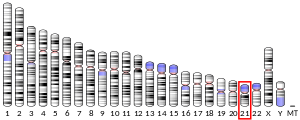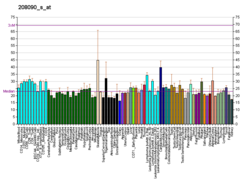
Back منظم المناعة الذاتية Arabic AIRE BS Autoimunitní regulátor Czech AIRE Welsh Autoimmun-Regulator German Regulador autoinmune Spanish Auto-immune regulator French Regulador autoinmune Galician AIRE Ukrainian 自體免疫調節因子 Chinese
The autoimmune regulator (AIRE) is a protein that in humans is encoded by the AIRE gene.[5] It is a 13kbp gene on chromosome 21q22.3 that encodes 545 amino acids.[6] AIRE is a transcription factor expressed in the medulla[broken anchor] (inner part) of the thymus. It is part of the mechanism which eliminates self-reactive T cells that would cause autoimmune disease. It exposes T cells to normal, healthy proteins from all parts of the body, and T cells that react to those proteins are destroyed.
Each T cell recognizes a specific antigen when it is presented in complex with a major histocompatibility complex (MHC) molecule by an antigen presenting cell. This recognition is accomplished by the T cell receptors expressed on the cell surface. T cells receptors are generated by randomly shuffled gene segments which results in a highly diverse population of T cells—each with a unique antigen specificity. Subsequently, T cells with receptors that recognize the body's own proteins need to be eliminated while still in the thymus. Through the action of AIRE, medullary thymic epithelial cells (mTEC) express major proteins from elsewhere in the body (so called "tissue-restricted antigens" - TRA) and T cells that respond to those proteins are eliminated through cell death (apoptosis). Thus AIRE drives negative selection of self-recognizing T cells.[7] When AIRE is defective, T cells that recognize antigens normally produced by the body can exit the thymus and enter circulation. This can result in a variety of autoimmune diseases.
The gene was first reported by two independent research groups Aaltonen et al. and Nagamine et al. in 1997 who were able to isolate and clone the gene from human chromosome 21q22.3. Their work was able to show that mutations in the AIRE gene are responsible for the pathogenesis of Autoimmune polyglandular syndrome type I.[5][8] More insight into the AIRE protein was later provided by Heino et al. in 2000. They showed that AIRE protein is mainly expressed in the thymic medullary epithelial cells using immunohistochemistry.[9]
- ^ a b c GRCh38: Ensembl release 89: ENSG00000160224 – Ensembl, May 2017
- ^ a b c GRCm38: Ensembl release 89: ENSMUSG00000000731 – Ensembl, May 2017
- ^ "Human PubMed Reference:". National Center for Biotechnology Information, U.S. National Library of Medicine.
- ^ "Mouse PubMed Reference:". National Center for Biotechnology Information, U.S. National Library of Medicine.
- ^ a b Aaltonen J, Björses P, Perheentupa J, Horelli-Kuitunen N, Palotie A, Peltonen L, et al. (Finnish-German APECED Consortium) (December 1997). "An autoimmune disease, APECED, caused by mutations in a novel gene featuring two PHD-type zinc-finger domains". Nature Genetics. 17 (4): 399–403. doi:10.1038/ng1297-399. PMID 9398840. S2CID 29785642.
- ^ Blechschmidt K, Schweiger M, Wertz K, Poulson R, Christensen HM, Rosenthal A, et al. (February 1999). "The mouse Aire gene: comparative genomic sequencing, gene organization, and expression". Genome Research. 9 (2). Cold Spring Harbor Laboratory Press: 158–66. doi:10.1101/gr.9.2.158. OCLC 678392077. PMC 310712. PMID 10022980.
- ^ Anderson MS, Su MA (April 2011). "Aire and T cell development". Current Opinion in Immunology. 23 (2): 198–206. doi:10.1016/j.coi.2010.11.007. PMC 3073725. PMID 21163636.
- ^ Nagamine K, Peterson P, Scott HS, Kudoh J, Minoshima S, Heino M, et al. (December 1997). "Positional cloning of the APECED gene". Nature Genetics. 17 (4): 393–8. doi:10.1038/ng1297-393. PMID 9398839. S2CID 1583134.
- ^ Heino M, Peterson P, Sillanpää N, Guérin S, Wu L, Anderson G, et al. (July 2000). "RNA and protein expression of the murine autoimmune regulator gene (Aire) in normal, RelB-deficient and in NOD mouse". European Journal of Immunology. 30 (7): 1884–93. doi:10.1002/1521-4141(200007)30:7<1884::aid-immu1884>3.0.co;2-p. PMID 10940877.





